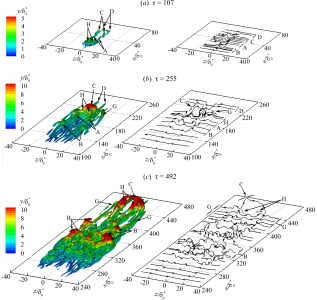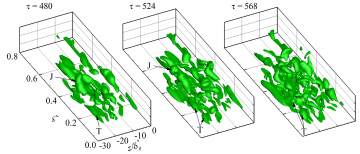Hairpin-like vortices have been identified as the dominant coherent flow structures in transitional and turbulent boundary layers and free shear layers. To better understand the characteristics of these flows, it is important to study the creation and growth mechanisms of the hairpin vortices and the resultant wave packets containing multiples of these flow structures. A turbulent spot in isolation provides a suitable environment to study how a hairpin vortex forms in a shear layer and how the formation of one such flow structure may produce a local flow environment that promotes the creation of similar structures in sequence.
The results of a DNS of a growing turbulent is shown in Fig. 1. The spot consists of packets of hairpin-shaped vortices. Broadly, the growth of the spot occurs through (i) the increase in the number and spatial scale of hairpin vortices within wave packets and (ii) the formation of new wave packets near the spanwise edges of the spot.
To understand the growth mechanisms on a quantitative level, the transport of turbulent enstrophy and kinetic energy is analyzed within the spot. For example, the variation in the spatial scale of coherent vortices due to the formation of new wave packets is shown in Fig. 2.
By understanding the growth mechanisms in an individual turbulent spot, the fundamental processes that drive the production of turbulence in other situations can be understood better. The next stages of this project is to incorporate the effect of periodic free-stream unsteadiness and surface roughness.

